Let's restrict attention to the specific problem of adding heat to a flow in a constant area duct. In that case, it is the value of H at the exit that we modify by adding heat. Let us examine when we get into trouble doing so.
To simplify, we will first create a single equation in the single
unknown ![]() like we did in the hand-out on normal shocks: we solve
(1) for
like we did in the hand-out on normal shocks: we solve
(1) for ![]() and substitute that into (2) and (3) to eliminate
u from those equations:
and substitute that into (2) and (3) to eliminate
u from those equations:
![]()
![]()
To make it even simpler, let's assume, (for this simplified example
only,) that we are dealing with a perfect gas, for which
![]() . Then, if we solve (2') for
. Then, if we solve (2') for ![]() and
put it into (3'), we get
and
put it into (3'), we get
![]()
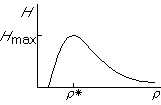
Now in the next figure we show what happens if, starting from an
arbitrary starting flow that we have indicated by a dot, we change the
value of H an infinitesimal amount ![]() :
:
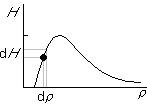
But clearly, there will be a problem when the initial state is at the maximum of the curve, because there the derivative f'=0, and we would be dividing by 0. In fact, there is really no solution if we try to raise H any more:
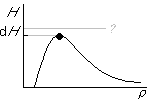
Now let's consider shocks. The two sides of a shock have the same total enthalpy H, so the two sides of an arbitrary shock show up in the graph as shown by the two dots:
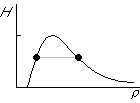
Remember that a weak shock is one in which the flow quantities,
including ![]() , barely change across the shock. From the figure,
it is clear that weak shocks must therefor be right at the maximum
of the curve:
, barely change across the shock. From the figure,
it is clear that weak shocks must therefor be right at the maximum
of the curve:
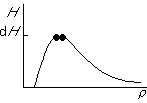
Also notes that since the Mach number crosses one at the maximum, and one side of an arbitrary shock is located before the maximum and the other side after it, one side of a shock will be supersonic, and one side subsonic. That is something that we proved earlier for perfect gases from the Prandtl relationship. Here we see it applies generally.
That summarizes how it all hangs together. In the next section we will do the full problem of three equations in three unknowns and an arbitrary gas.